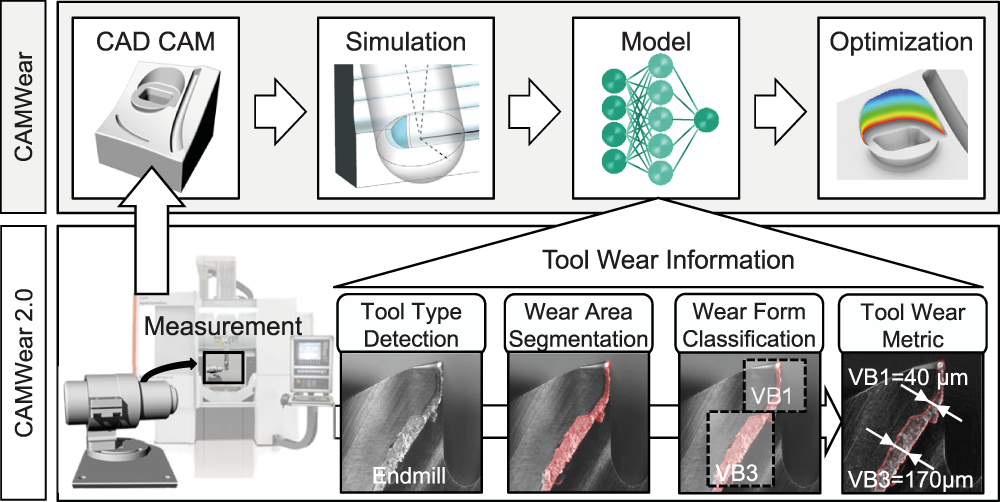Research Project "CAMWear 2.0"
Tool wear is a cost driver in metal cutting manufacturing. It is often a reason for reduced quality of the product leading to extensive reworking as well as increased component scrap. Therefore, wear measurements are regularly carried out during ongoing production, which, however, extends production times.
Common systems for determining the wear condition of cutting tools are measuring microscopes and laser measuring bridges. However, both have some weak points: Microscopes are located outside the machine tool, are very expensive to purchase and require time-consuming manual operation. Laser measuring bridges can be integrated into the machine, but do not offer the possibility of identifying and measuring different types of wear. It is therefore not possible to determine causes and make recommendations for action. In addition, common wear metrics such as width of flank wear land cannot be derived.
In order to avoid the described wear-related consequences, tools are usually replaced too early rather than too late in practice. In a survey conducted in 2020 with application engineers from a research community of tool and die makers (WBA Aachener Werkzeugbau Akademie), the unused tool life was estimated at around 30 %.

Consistent quantifiability of the wear condition of cutting tools
The aim of the "CAMWear 2.0" research project was to develop a system that precisely records and evaluates the wear condition of cutting tools in near real time during the milling process.
To this end, the researchers integrated a microscope into the milling machine. The microscope automatically captures images of the milling tool during machining, between the individual machining steps. Inspired by medical technology processes, the team developed techniques for image segmentation, on the basis of which industry-typical evaluation parameters of the tool condition can be derived. To protect the sensitive microscope, the researchers designed a rugged housing with a sealing air function that keeps cooling lubricant droplets away from the camera.
Photos and synthetic image data as the basis for an AI-generated wear model.
The captured images serve as training data for an AI-powered image processing program that the partners also developed during the project. The program is able to classify tool types, highlight worn areas and calculate wear metrics.
To reduce the upstream manual effort required to train the artificial intelligence, the researchers used a new approach: they create synthetic image data using generative algorithms and neural networks to artificially increase the database. In addition, the real images are modified and multiplied using simple augmentation techniques, such as flipping or rotating.
Successful practical test confirms performance
The camera system and the image processing program were successfully subjected to a practical test under real conditions in the final phase of the project: The automation of image capture and the quality of the captured photos were very good. The camera housing proved to be robust enough to reliably protect the microscopy unit. The AI of the image processing software very reliably and accurately identified the visually detectable wear shapes.
The application is now being further optimized specifically for industrial use: Another goal is to further refine the AI models in order to identify and analyze wear phenomena even more precisely. In close cooperation with specialized hardware suppliers, the new AI application is to be rapidly transferred to industrial practice.
Funding
The project "CAMWear 2.0 - Automated wear measurement and analysis to optimize process planning in milling" was funded by the German Federal Ministry for Economic Affairs and Energy (BMWi).
Funding code: 21660 N / 2
Project partner
Research Association Programming Languages for Manufacturing Facilities e. V.
